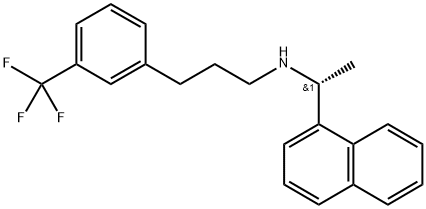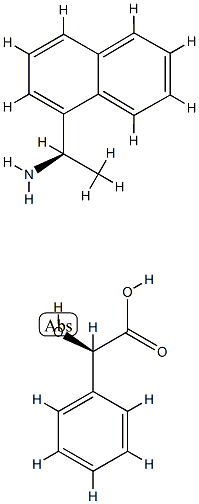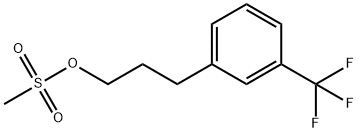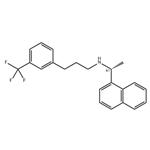Mechanism
Cinacalcet(226256-56-0) is a basic single-chain peptide hormone secreted by the parathyroid chief cells , called PTH, it is a blend of 84 amino acids,it has an effect of elevating serum calcium and lowing phosphorus, regulating calcium and phosphorus metabolism balance of vertebrate body . In parathyroid cells,the first main precursor of PTH is synthesized at first, it is called Prepro-parathyroid, containing 115 amino acids, the predecessor of the substance after cell lysis in the thyroid becomes the second precursor substance,it is called parathyroid-hormone containing 90 amino acids , the latter becomes polypeptide containing 84 amino acids by cleaving within the cell, that is PTH. Normal human plasma PTH concentration is about 1 ng/ml.
The main physiological function of parathyroid hormone is promoting osteolysis, bone calcium mobilization into the blood, increasing calcium, increasing vigor of serum and bone alkaline phosphatase ;it can inhibit renal tubular reabsorption of phosphate, promote urinary excretion of phosphorus , decrease phosphorus; PTH via activation of vitamin D3, indirectly promotes intestinal absorption of calcium, magnesium and phosphorus. PTH secretion is mainly affected by the regulation of calcium concentration. Blood Ca2 + elevates, PTH secretion reduces; blood Ca2 + decreases, secretion is increased. In addition, phosphorus increasing via reducing calcium stimulates the secretion of PTH, calcitonin massive release can also promote increasing secretion of PTH.
Serum parathyroid hormone except for the study of parathyroid disease, has a certain value on the differential diagnosis of hypercalcemia and hypocalcemia The main clinical significance is as follows:
1. Diagnosis of parathyroid disease. When there are hyperparathyroidism or ectopic PTH secretion disorder, PTH increases ; when there are hypoparathyroidism, parathyroid surgery or radiation damage, etc., PTH decreases.
2. Identification of hypercalcemia and hypocalcemia. When abnormal calcium is caused by calcium parathyroid disorders ,serum calcium lifts as serum PTH lifts, while abnormal blood calcium is caused by other causes , PTH does not change.
The above information is edited by the Chemicalbook of Tian Ye.
Description
Cinacalcet is the first type II calcimimet ic agent approved that improves CaSR sensi Tivity to calcium .
When calcium is bound to the CaSR, phospholipase C is act ivated, and the secretion of PTH is inhibited. In the
presence of cinacalcet , not only is a drop in
PTH levels observed but also a decrease in serum calcium and phosphorous levels.
Chemical Properties
Yellow Oil
Uses
Cinacalcet is the first calcimimetic drug approved by the United States Food and Drug Administration for the treatment of secondary hyperparathyroidism in patients with chronic kidney disease
Uses
macular degeneration therapy
Uses
Labeled Cinacalcet, intended for use as an internal standard for the quantification of Cinacalcet by GC- or LC-mass spectrometry.
Definition
ChEBI: Cinacalcet is a secondary amino compound that is (1R)-1-(naphthalen-1-yl)ethanamine in which one of the hydrogens attached to the nitrogen is substituted by a 3-[3-(trifluoromethyl)phenyl]propyl group. It has a role as a calcimimetic and a P450 inhibitor. It is a member of naphthalenes, a secondary amino compound and a member of (trifluoromethyl)benzenes.
brand name
Sensipar (Amgen).
Clinical Use
Cinacalcet hydrochloride is a second-generat ion calcimimetic approved for the treatment of secondary
hyperparathyroidism in patients wi th chronic kidney disease on dialysis and for the treatment of hypercalcemia
in patients with parathyroid cancer . It can be used alone, with vitamin D, and/or with a phosphate binder .
Side effects
Common side effects of Cinacalcet are nausea, vomiting, dizziness, diarrhoea and loss of appetite.Cinacalcet can cause hypocalcaemia. Patients taking this medication need to be followed closely for common symptoms associated with hypocalcaemia, including tingling, muscle twitching, cramps, mood changes or irritability. On the ECG, there may be a prolonged QT interval. Patients with a history of congenital long QT syndrome, a family history of long QT syndrome, and other conditions predisposing them to prolonged QT intervals may be at increased risk. PTH oversupport can lead to ankylosing bone disease.
Drug interactions
Potentially hazardous interactions with other drugs
Antifungals: metabolism inhibited by ketoconazole.
Hormone antagonists: metabolism of tamoxifen to
active metabolite inhibited - avoid.
Tobacco: metabolism increased by tobacco.
Metabolism
Cinacalcet is rapidly and extensively metabolised by
cytochrome P450 isoenzymes CYP3A4 and CYP1A2, by
oxidation followed by conjugation. The major circulating
metabolites are inactive, and are renally excreted, with
80% of the dose recovered in the urine, and 15% in the
faeces.







